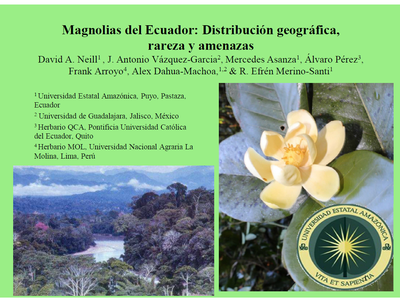Magnolias of Ecuador: Geographic Distribution, Rarity and Threats
DAVID A. NEILL1, Keynote Speaker
J. ANTONIO VÁZQUEZ-GARCIA2, MERCEDES ASANZA1, ALEX DAHUA-MACHOA2, EFRÉN MERINO-SANTI1, ÁLVARO J. PÉREZ3 & FRANK ARROYO4
- Universidad Estatal Amazónica, Puyo, Pastaza, Ecuador
- Universidad de Guadalajara, Jalisco, Mexico
- Herbario QCA, Pontificia Universidad Católica del Ecuador, Quito
- Herbario MOL, Universidad Nacional Agraria La Molina, Lima, Peru
Until 2010, only five native species of Magnolia had been recorded in the forests of Ecuador. With the floristic inventories in the country in the last decade and the taxonomic revisions of the genus, in 2019 this figure now amounts to 24 native species of Magnolia for Ecuador, including an unpublished species. A total of 19 species are considered endemic to Ecuador; four species are shared with Peru and one with Colombia. The Magnolias of Ecuador are distributed in all the regions of humid forests in the country: six species in the northwestern region of the Pacific Coast and the western slopes of the Andes, six species in the eastern slopes of the Andes, six in the lowlands of the Amazon, and six in the Cordillera del Cóndor in the southeast. Magnolias have not been recorded in the dry forest region in the southwestern part of the country. Most of the Magnolia species of Ecuador are restricted to very limited geographical areas and with very small local populations. For example, Magnolia canandeana is known only from three adult individuals, each greater than 30 m in height and 100 cm in diameter, within a private reserve of 1300 hectares in the coastal region where deforestation continues to eliminate large areas of native forests each year. Another example is Magnolia yantzazana in the Cordillera del Cóndor region, in southeast Ecuador near the border with Peru; about 20 individuals are known, within an area of about 10 km², and entirely within a mining concession. In the case of M. yantzazana, the mining company was provided a map with the exact location of each known individual and is taking steps to protect this threatened species with a plan to mitigate the impacts of the mining operation and leave intact the forest areas where the trees have been recorded. Some species of Magnolia in Ecuador often pass unnoticed in the dense humid forests and were discovered only because they appeared in inventories of permanent plots of one hectare or ¼ hectare where all the trees in the plot were meticulously recorded. These "rarity" patterns at local and regional scales make it difficult to implement conservation activities for the species. Efforts are ongoing to establish ex situ living collections of the Ecuadorian species of Magnolia in botanical gardens, but difficulties in propagation pose a challenge for ex situ conservation. According to the threat assessments using the IUCN Red List criteria, six species of Magnolia in Ecuador are Critically Endangered (CR), four are Endangered (EN), six Vulnerable (VU), one Near Threatened (NT) and three of Lesser Concern (LC). At least one species is possibly extinct: M. neillii has not been recorded in more than 30 years and its known area of distribution, in the petroleum-producing region of lowland Amazonian Ecuador, has been almost completely deforested.

